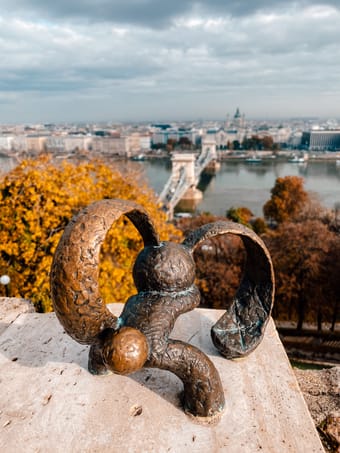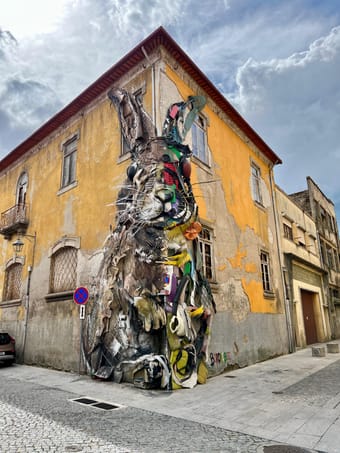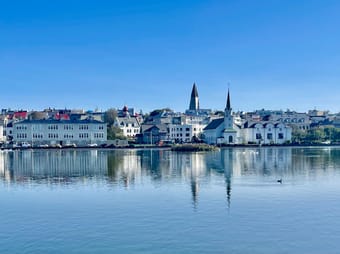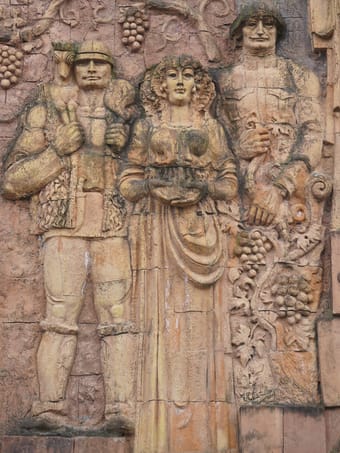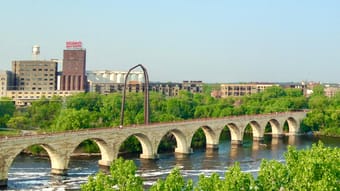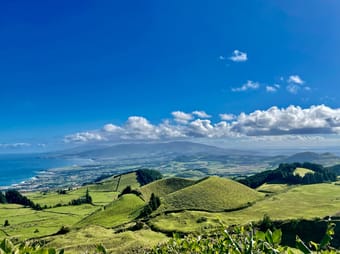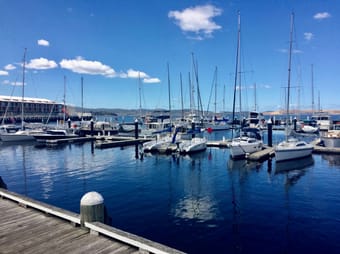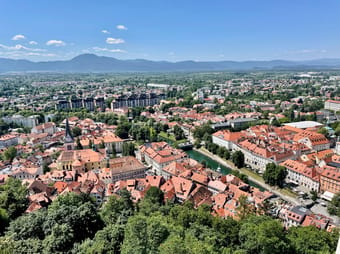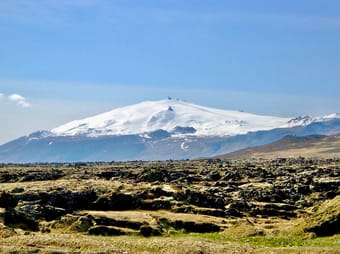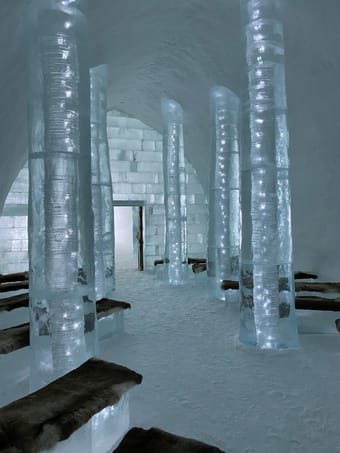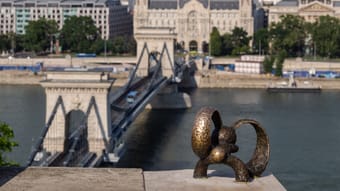Results for Sculpture
Budapest boasts a lot of beautiful scultpures throughout the city but did you know there are over 30 mini sculptures dispersed throughout as well? Made by Hungarian-Ukrainian artist Mihály Kolodko, they are a lot of fun to discover and to learn a small bit about Budapest history as well! Below you will find a list of where all the mini sculptures are located within Budapest and the towns nearby. Have fun!
Groups • Female Solo • Couples • Backpacker • Family • History • Budget • Slow Travel
Free
8
What makes a sightseeing tour fun? Especially when kids are around? Conventional tour buses are okay, but I rather try to find alternative ways to explore a city. For this, I have an amazing idea. 🤩
Budapest has been conquered by mini sculptures made by Mihály Kolodko - a Ukrainian sculptor, who moved to Budapest in 2017. These mini sculptures are mostly made out of metal & after installation, he usually posts only a photo (maybe a hint) on socials, about the location of the new addition.
IMAGINE a family approved sightseeing tour in Budapest, where the small child(ren) can play ’treasure hunt’ searching for these art installations, 🕵🏼 while the whole family gets a unique glimpse of Budapest’s city center. Personally, I love unique ideas & for me it would be a perfect alternative approach for a traditional sightseeing tour.
Family • Groups • Couples • Adventure • Budget • Outdoors • Architecture
$15.00
0
Wisconsin is home to several notable public art sculpture parks and grottos, each offering unique experiences and artistic expressions that attract visitors from near and far. These destinations serve as cultural landmarks, blending natural beauty with creative human endeavor, making them compelling reasons for the public to visit.
Why the Public Should Visit:
Cultural Enrichment: Visiting Wisconsin’s public art sculpture parks and grottos offers an opportunity to engage with diverse artistic expressions and cultural narratives. These spaces foster cultural enrichment by showcasing local and international art, fostering dialogue, and promoting artistic appreciation among visitors.
Natural Beauty: Many of these parks and grottos are nestled in Wisconsin’s scenic landscapes, offering a harmonious blend of art and nature. Visitors can enjoy peaceful surroundings, scenic views, and serene environments that enhance the overall experience of exploring art in an outdoor setting.
Educational Value: These destinations provide educational opportunities for visitors of all ages. They offer insights into art history, techniques, and cultural significance, making them valuable resources for schools, students, and lifelong learners interested in expanding their knowledge of art and culture.
Community and Recreation: Public art sculpture parks and grottos often serve as community gathering spaces and recreational destinations. They host events, festivals, and workshops that bring people together, fostering a sense of community and cultural vitality.
Spiritual and Reflective Spaces: Grottos, in particular, offer spiritual and reflective spaces where visitors can find solace, contemplate their beliefs, and connect with something larger than themselves. They provide a sanctuary for introspection and spiritual renewal, appealing to visitors seeking moments of quietude and contemplation amidst the beauty of art and nature.
50+ • Couples • Female Solo • Digital Nomads • Groups • Adventure • Outdoors • Photography • Road Trip • Slow Travel • Sustainable/Eco
Free
4
One man's trash is another man's treasure 💙 Artur Bordalo, also known as Bordalo II (pronounced Bordalo Segundo), was born in 1987 in Lisbon, Portugal. He is famous for using street garbage and discarded materials to create stunning animal sculptures. His underlying message is about excessive consumerism and waste, pollution and all types of endangered species. His works, which can be found all over the world, are referred to as "trash art."
This free guide includes:
🔹52 art installations of Bordalo II in & around Portugal, broken down by region
🔹Interactive map with tagged locations (use the map icon below to toggle between the guide and full map)
🔹All but a few are found outdoors (some are in restaurants as noted), and free of charge to view!
This is not an exhaustive list by any means, and not all of his pieces are permanent exhibits. But hopefully it will help you keep your eyes open for Bordalo's work while traveling around Portugal. His art pieces are really unique and I hope you enjoy spotting them in the wild as much as I do!
If this guide was helpful and you'd be interested to see more like this in the future, please let me know in the comments below! Thanks for supporting my work! 🫶🏻💙
Car-free • Couples • Backpacker • Digital Nomads • Family • Groups • Female Solo • 50+ • Adventure • Architecture • Art • Design • Photography • People & Culture • History • Road Trip • Slow Travel • Wine
$14.99
45
Reykjavík is the capital and largest city in Iceland. It’s also the northernmost capital in the world. The city, on the southwest coast of the island nation, is home to less than 150,000 people (that’s 60% of the total population). It’s by no means sleepy, though. It has a thriving art scene (music festivals, independent record stores, pop-up exhibits) and foodie spots (Michelin restaurants, organic wine bars, coffee culture). A grand church towers over the city. Candy-colored houses line the streets. Thermal swimming pools are gathering spots for most neighborhoods. Northern lights sightings are a real possibility (seasonally, of course). It’s also the jumping-off point for exciting adventures all around the Land of Fire and Ice. Pack for all seasons, as the weather changes frequently throughout the day--no matter what time of year it is. And be prepared to fall in love.
This detailed guide includes:
Places: islands, neighborhoods
Stay: hotels
Eat: bakeries, cafés, coffee shops, food carts & halls, ice cream, Michelin stars, restaurants
Drink: beer bars, breweries, cocktail bars, wine bars
Shop: beauty products, bookstores, chocolate shops, clothing boutiques, flea markets, outdoor wear, record stores, vintage clothing, wool products
Do: art museums, churches, concert venues, history museums, lakes, memorials, parks, peace stones, roads, sculptures, sports venues, squares, streets
Transportation: airports, bus terminals, car rentals, ferries
Note: I travel to Reykjavík quite frequently, so this guide is updated often.
Car-free • Art • Boutique • Foodie • People & Culture • Coffee • Design • Shopping • History
$30.00
3
Raw. Remote. Untamed. Tasmania is just waiting to be discovered. Clean air. Dense rainforests. Deserted beaches. Dramatic sea cliffs. Fascinating wildlife. Glacial valleys. Gorgeous national parks. Hidden caves. Deep lakes. Multi-day hikes. Rugged islands. Wild rivers. Windswept coastlines. Are you curious yet? Add emerging cities, award-winning wineries, straight-from-the-ocean seafood, and gorgeous lodges. Australia's smallest and least-populated state is starting to command attention. It's about time. The island is beautiful. Historic Hobart is now luring artists and foodies. While road trips move through diverse landscapes within relatively short distances. Tassie is not an accidental destination. But those who make the long journey will feel both at home and surprised at every turn.
The Tasmania Guide focuses on Hobart, wine country, and three national parks.
This detailed guide includes:
Places: regions, cities, neighborhoods, towns, peninsulas
Stay: hotels
Eat: cafés, farms, food stands, restaurants
Drink: breweries, cocktail bars, distilleries, wineries
Shop: bookstores, local produce
Do: art museums, bays, beaches, bridges, city parks, coves, docks, gardens, hikes, lakes, lookout points, memorials, mountains, national parks, piers, rivers, sculptures, squares, stairs, trails, waterfalls, wharfs, wine tours
Transportation: airports, ferries, highways
Adventure • Boutique • Foodie • Luxury • Outdoors • Relaxation • Road Trip • Art • History • Shopping • Wine
$30.00
2
Active volcanoes. Dancing northern lights. Gushing geysers. Massive glaciers. Thermal hot springs. Thundering waterfalls. Iceland is the ultimate adventure destination. How have you not been here yet? It’s finally time. Start in the northernmost capital in the world. Reykjavik is a hip, modern city. Then start exploring the wild coastline, the sheep-filled countryside, the icy interior, and the peaceful islands. There are plenty of black-sand beaches, small fishing villages, turf-roofed houses, and epic hikes along the way. Just remember to pack layers. Sometimes, the Gulf Stream provides moderate temperatures. Other times, it’ll feel like you’re in the Arctic. Also don’t forget the long, dark winters and the 24-hour daylight during the short summers. If you take advantage of Icelandair’s free stopover program—a great excuse to visit Helsinki, Copenhagen, and even Paris—you can keep returning to discover which season you like best.
This detailed guide includes:
Places: regions, cities, islands, peninsulas, towns, neighborhoods
Stay: hotels
Eat: bakeries, cafés, coffee shops, food carts & trucks, food halls, ice cream, Michelin stars, pizzerias, restaurants, soup
Drink: beer bars, breweries, cocktail bars, wine bars
Shop: beauty products, bookstores, Christmas stores, chocolate shops, clothing boutiques, flea markets, knitwear, outdoor wear, record stores, vintage clothing, wool products
Do: art museums, bays, beaches, bridges, caves, churches, concert venues, cultural centers, fjords, geothermal areas, geysers, harbors, hikes, history museums, horseback riding, hot springs, lagoons, lakes, lighthouses, memorials, mountains, national forests, national parks, natural wonders, nature reserves, parks, peace stones, ponds, roads, rock formations, rocks, rootless cones, scenic drives, sculptures, shipwrecks, sports venues, squares, streets, swimming pools, thermal baths, tunnels, valleys, viewpoints, volcanoes, walks, waterfalls
Transportation: airports, bus terminals, car rentals, ferries, parking lots, transfers
Note: I travel to Iceland frequently, so this guide is updated often.
Adventure • Art • Boutique • Foodie • History • Nature • Slow Travel • Road Trip • Beach • Coffee • Design • Outdoors • People & Culture • Wellness • Relaxation
$40.00
1
Saskia Veendorp
Available for hire
Kutaisi: A weekend of architecture, culture, sanitoriums, and Soviet-era relics.
Embark on a picturesque weekend escape to the enchanting city of Kutaisi, nestled approximately 220 kilometers west of Tbilisi (a 3.5-hour drive). Serving as the capital of the historic Imereti region and boasting a legacy as one of Europe's oldest settlements, Kutaisi exudes an "old world" village-like ambiance complemented by chic boutique hotels and a burgeoning culinary and cultural scene. Spend your days exploring lively food markets, marveling at the Soviet-era relics, and delving into quirky museums. During the early 19th century, Kutaisi flourished as the epicenter of Georgian creativity, nurturing renowned playwrights, authors, and poets. Today, sculptures and bas-reliefs honoring local musicians, artists, and literary luminaries embellish its streets, reflecting its rich cultural heritage. Nestled alongside the Rioni River amidst sprawling tea fields and hilly farmland, the city also serves as the perfect launchpad for exploring the surrounding countryside. And don't miss the chance for an urban exploration adventure in Tskaltubo, where you'll experience a surreal, post-apocalyptic wasteland of abandoned sanatoriums.
Architecture • Boutique • Design • History • Foodie • Photography • Slow Travel • Sustainable/Eco • Wine
Free
1
If you only have a few hours or days in the Twin Cities, then I recommend these must see and do!
1. Mall of America
2. Walker Art Center and Minneapolis Sculpture Garden
3. Grand Ave
4. Stone Arch Bridge
5. Lake Minnetonka
50+ • Accessibility • Backpacker • Business • Car-free • Couples • Digital Nomads • Family • Gluten-free / Celiac • Groups • Halal • LGBTQ+ • Pets • Plus Size • Female Solo • Vegan • Vegetarian • Adventure • Architecture • Art • Boutique • Budget • Coffee • Design • Foodie • History • Outdoors • People & Culture • Photography • Relaxation • Road Trip • Shopping
Free
1
There are secret islands in the middle of the North Atlantic Ocean. Nine of them, actually. The Azores are an autonomous region of Portugal, even though they're nearly 900 miles off the coast of Lisbon. Mount Pico, on the island of Pico, is actually the highest point in the European country. The volcanic archipelago is covered with farmland. Small fishing communities line the coasts. Travelers were first introduced to the remote islands when they became a refueling stop for flights between Europe and North America. Direct flights from Boston and New York eventually followed.
The Azores are finally being discovered by North Americans without Portuguese heritage. It's about time. Ponta Delgada, the little capital, mixes historic buildings with modern hotels and restaurants. São Miguel, the main island, is full of hiking trails and hot springs. Pico Island is famous for its wine. While seven other islands are just waiting to be explored. With mild climate, thanks to the jet stream, the Azores are a year-round destination. Go before the secret gets out.
This detailed guide includes:
Places: islands, cities, neighborhoods, towns, hidden villages
Stay: hotels
Eat: bakeries, coffee shops, ice cream stands, pizzerias, restaurants, teahouses
Drink: beach bars, rooftop bars, tapas bars, wineries
Do: abandoned hotels, aqueducts, bamboo groves, beaches, botanical gardens, bridges, chapels, churches, fountains, fumaroles, gardens, gates, hikes, lakes, marinas, mountains, natural swimming pools, nature preserves, public parks, roads, sculptures, squares, statues, tourist offices, UNESCO World Heritage Sites, viewpoints, windmills
Transportation: airports, car rentals, ferries, parking lots
Adventure • Boutique • Design • Foodie • Luxury • Outdoors • People & Culture • Relaxation • Road Trip • Wine • Coffee • Faith • History
$30.00
0
São Miguel Island is the largest--in both size and population--of the Azores. The Green Island was discovered and claimed by the Portuguese in the early 15th century. Mild climate and fertile volcanic soil made the island appealing for settlers. It quickly became an export hub for in-demand sugar. A fishing industry eventually followed. Now it's tourists who are flocking to the island. They're lured by black-sand beaches, hidden hot springs, lake-filled craters, Europe's only tea plantations, quiet hiking trails, volcanic hills, and whale-watching tours. Be sure to spend some time in Ponta Delgada, the easy-to-navigate capital, as well.
This detailed guide includes:
Places: cities, neighborhoods, towns, hidden villages
Stay: hotels
Eat: coffee shops, ice cream stands, restaurants, teahouses
Drink: beach bars, rooftop bars
Do: abandoned hotels, aqueducts, bamboo groves, beaches, botanical gardens, bridges, chapels, churches, fountains, fumaroles, gardens, gates, hikes, lakes, marinas, nature preserves, public parks, roads, sculptures, squares, statues, tourist offices, viewpoints
Transportation: airports, car rentals, parking lots
Adventure • Architecture • Boutique • Foodie • Luxury • Outdoors • People & Culture • Relaxation • Road Trip • Coffee • Faith • History
$25.00
0
Hobart (nipaluna) is the capital and largest city of Tasmania. It's also Australia's southernmost state capital. The city sits at the base of Mount Wellington (kunanyi) and on an estuary of the River Derwent along the island's southeast coast. It's home to about half a million people (that's 40% of the total population). This land was occupied by the Aboriginal Tasmanians before the British founded a penal colony 1804. Whalers, miners, farmers, and, eventually, Antarctic explorers, followed. Tourism has only recently begun to dominate the economy.
Hobart's historic waterfront has cobblestone streets and sandstone warehouses. They're now full of new hotels, exciting art galleries, and locally sourced markets. Battery Point has colonial cottages and cute cafés. The eery Convict Trail starts here. The Museum of Old and New Art (MONA) is just a quick ride up the River Derwent. Mount Wellington hikes offer a great lay of the land. Craft breweries and distilleries keep popping up inside the city; wineries lie just outside. While the restaurant scene is booming. Hobart is more than just a stopover. You should plan to spend at least a few days getting to know Tassie's capital.
This detailed guide includes:
Places: cities, neighborhoods, towns
Stay: hotels
Eat: cafés, restaurants
Drink: cocktail bars, distilleries
Shop: bookstores, local produce
Do: art museums, bridges, coves, cranes (really!), docks, gardens, memorials, parks, piers, rivers, sculptures, squares, stairs, trails, wharfs
Transportation: airports, ferries, highways
Adventure • Art • Boutique • Foodie • History • Shopping • Design • People & Culture
$20.00
0
Ljubljana is the capital and largest city in Slovenia. The Dragon City, which straddles the Ljubljanica River, survived Roman, Habsburg, and Yugoslavian rule to lead the mountainous country into independence. Slovenia has become the Green Heart of Europe, while Ljubljana is one of the greenest capitals on the continent.
This charming city is home to less than 300,000 people. It's a university town, a tech center, and an artist's haven. The Old Town is full of Baroque buildings with red-tiled roofs, detailed bridges, and lively squares. Cafes with terrace seating line the river, which is used by kayakers and sightseeing boats. New hotels, restaurants, and wine bars keep popping up in this car-free area. While Ljubljana Castle stands on a hill overlooking it all.
The compact city is a central base for adventures all over the small country. But best of all: Ljubljana still feels like an under-the-radar destination. Go fall in love with this enchanting city before everyone else catches on.
This detailed guide includes:
Places: neighborhoods
Stay: hotels
Eat: cafés, pizzerias, restaurants
Drink: lounges, wine bars
Shop: antique markets, toy stores
Do: bridges, castles, cathedrals, churches, city models, fountains, funiculars, monuments, parks, puppet museums, rivers, sculptures, squares, statues
Car-free • Boutique • Foodie • Wine • Art • Faith • History • People & Culture • Shopping
$20.00
0
When you head north from Reykjavík, it doesn't take long to leave the Capital Region and enter West Iceland. The city immediately feels very far away. This area is home to the Snæfellsnes Peninsula and Snæfellsjökull National Park. It's filled with sleeping volcanoes, receding glaciers, thundering waterfalls, lupine-covered valleys, small fishing villages, black churches, and isolated lighthouses. There's a lot to see within relatively short driving distances. It's a good place to start your real Icelandic adventure.
This detailed guide includes:
Places: cities, peninsulas, towns
Stay: hotels
Eat: cafés, coffee shops, food trucks
Do: beaches, bridges, churches, fjords, horseback riding, lagoons, lighthouses, national parks, natural wonders, rocks, sculptures, shipwrecks, viewpoints, waterfalls
Transportation: ferries
Adventure • Boutique • Outdoors • Relaxation • Road Trip
$20.00
0
Ever thought about sleeping on ice? How about in an Ice Hotel? Every year, a small, northern town in Sweden makes an Ice Hotel. Located in Jukkasjärvi in the Arctic Circle, it is constructed and designed by numerous ice sculptors from around the world.
My recommendation is to fly from Stockholm to Kiruna, then use the shuttle service to Jukkasjärvi.
I stayed one night in the Ice Hotel and one night in a normal hotel.
Visiting all the rooms, chapel, and sculptures throughout the property is the highlight.
You can also enjoy snowmobile rides to see the northern lights, ice fishing, and snowshoeing. There is also a nearby reindeer park where you can interact with real, live reindeer. As well as a Sámi museum to know about the native Sámi culture.
Make sure you are well prepared with warm, winter gear. The hotel does offer some clothes and boots for the stay in the Ice Hotel.
50+ • Backpacker • Business • Car-free • Couples • Digital Nomads • Family • Plus Size • Female Solo • Vegan • Adventure • Architecture • Art • Camping • Design • Foodie • History • Outdoors • People & Culture • Photography • Romantic • Slow Travel
$6.30
$7.00
10% off
0
Khajuraho, an ancient town situated in central India is a UNESCO heritage site known all over the world for its temple architecture and exquisite sculptures. The temples were built between the 9th and 11the centuries by the warrior kings of the Chandela dynasty. It is believed that 85 temples were built out of which 25 still remain.
This comprehensive two-day Khajuraho travel guide includes:
✈️How to reach
🧳Two-day itinerary
🏯Points of interest
🏠Stay options
🍽️Restaurant suggestions
⌛Best time to visit
➕Additional activities and attractions
50+ • Backpacker • Couples • Digital Nomads • Family • Female Solo • Vegetarian • Adventure • History • Outdoors • Slow Travel • People & Culture
Free
0
For art lovers who would like to explore Budapest and are up for a challenge in the meantime.
This uncommon guide invites you to take a walk on the Buda side, and see some of what Hungary’s capital has to offer whilst visiting Kolodko’s miniature sculptures.
Accessibility • Backpacker • Car-free • Couples • Digital Nomads • Family • Groups • Female Solo • Art • History • Outdoors • Photography • Slow Travel • Sustainable/Eco
Free
0
Ask ThatchGPT

